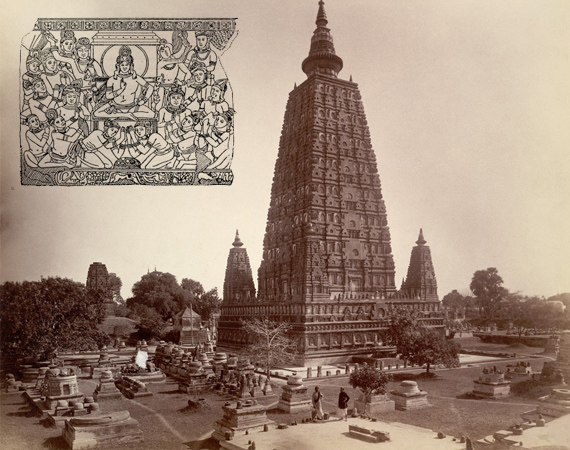
These places have attracted countless visitors from all over to worship, and many temples, towers, and inscriptions were also built around these holy places. However, during the decline of Buddhism in India, a few holy places were abandoned and destroyed by dust and time.
Introduction :
The 6th century BC was the golden century of Asian religions. Great historical events happened one after another in Eastern countries: Confucius and Lao Tzu in China, Zoroaster in Iran (Persia), Mahavira and Shakyamuni Buddha in India.
In that religious whirlwind, the Buddhist temple founded by Buddha Shakyamuni stood firm and continued to grow like a bright torch to meet the spiritual needs of humanity. Buddha has brought people a perfect spiritual life. Of course, the Buddha did not escape the general law of the universe “formation, existence, destruction, emptiness” and also experienced countless ups and downs in the history of peoples and religions. spear; But Buddhism still exists and remains forever in the life stream of the countries where Buddhism has passed through and left its mark.
When talking about Buddhism, we should mention the founder of that religion.
In the 6th century, 566 BC, in the city of Kapilavatsu of a small kingdom in India, Prince Siddhartha was born amid the glorious solemnity of the king. royal family and people. The Crown Prince is the son of King Sudhodana and Queen Mayadevi. The Crown Prince was born in Lumbini garden, near the border of Nepal and India.
A Taoist priest predicted that “The Crown Prince will either become a king ruling over the four continents of the world, or he will become a monk and attain Supreme Enlightenment.” When his father heard this, he quickly found him. all kinds of ways to prevent it. But those methods were all ineffective, even the Crown Prince’s talented wife, Princess Da Du Da La (Yasodhara) and their newborn child Rahula (Rahula), could not suppress the thought of escape. all worldly ties of the Crown Prince. The Crown Prince has seen the birth, old age, illness, and death of humans, has clearly understood the impermanence and change of all living things, and the Crown Prince wants to find a way to liberate suffering for himself and humanity. Not long after that, the Crown Prince left the palace, left his family home, and ventured into the dust.
After 11 years of searching for a master, learning asceticism, and worshiping and seeking enlightenment with many famous masters, Bodhisattva Siddhartha still did not feel satisfied. He realized that the practice methods and theories of the masters were still negative and deadlocked. He immediately abandoned that practice and went alone to meditate on the banks of the Ni Lien Thien River (Uruvila). After 49 days and nights of meditating, Bodhisattva Siddhartha suddenly attained great enlightenment, attained Supreme Enlightenment, and took the title Buddha Shakyamuni. After attaining the truth, Buddha went to meet the five brothers Kieu Tran Nhu at Deer Park. The Buddha’s first sermon on the Four Noble Truths was called Dhamma – Chakrapravartana. The teachings of the Four Noble Truths (Suffering, Origin, Cessation, Path) throughout the Noble Eightfold Path or Noble Eightfold Path (Right View, Right Thought, Right Speech, Right Action, Right Livelihood, Right Effort, Right Concentration, Right Mindfulness) have been Guide many people to liberation from the river of suffering to the shore of bliss and happiness.
For 45 years, Buddha and his great disciples traveled throughout India, from the banks of the Ganges River to remote villages, mainly to spread the Dharma to liberate sentient beings. Wherever the light of Buddhism spreads, the darkness of ignorance disappears. Millions and millions of people have found happiness and liberation. The Buddha passed away at Kusinagara in 486 BC. That year, he was 80 years old.
Buddhism has flourished in India, especially in Kosala and Magadha, also known as Buddhist centers. But after the Buddha passed away about 200 years, Buddhism also followed historical events with many ups and downs. Among those historical events, the disastrous battle with King Asoka’s Kalinga army was a famous turning point in the history of Indian Buddhism.
King Ashoka shuddered and woke up from his kingly dream when he saw the bloody corpses of men and horses lying dead on the battlefield. That bloody image strongly stirred the heart of that brutal king, making him regret causing the massacre and destruction of living beings. From then on, Ashoka transformed his soul, learned about Buddhism and through its teachings, he gradually tamed and became the most virtuous king in Indian history.
The remaining Buddhist relics in Indian territory all have the seal of restoration by King Ashoka; Thanks to that, today we can learn and understand more about Buddhist historical relics through inscriptions and holy places.

Holy Places
Buddha Shakyamuni left his footprints throughout the Indian territory and his image was deeply engraved in the minds of humanity. During the period of flourishing Dharma, important places were mentioned. Four famous holy places of Buddhism in particular and of India in general are: Lumbini Garden where the Buddha was born, Bodh-Gaya where the Buddha attained enlightenment, Deer Park (Sarnath) ) where the Buddha first turned the wheel of dharma, and Kusinagara where the Buddha passed away.
Four other important places are also mentioned in the history of Buddhism as the four places where the Buddha performed his miraculous powers to teach and subdue living beings. Those places are: Sravasti (the capital of Kosala) where the Buddha performed miraculous powers to subdue Puruna Kasyapa, the leader of the Tirthika sect (the religion of worshiping the fire god). The second place is Sankasya, where Buddha ascended to the 33rd heaven to educate Queen Ma Gia (his mother). The third place is Rajagriha (the capital of Magadha), where the Buddha subdued the drunken elephant ordered by Devadatta to kill the Buddha. The fourth place is Vaisali, where the Buddha enjoyed a bowl of honey offered by a group of monkeys.
These famous places and events in the Buddha’s life have been the subject of thousands of Buddhist works of art from ancient times to the present.
These places have attracted countless visitors from all over to worship, and many temples, towers, and inscriptions were also built around these holy places. However, during the decline of Buddhism in India, a few holy places were abandoned and destroyed by dust and time.
Today, Indian archaeologists are on their way to re-excavate the relics and restore the holy places.
First holy place: Lumbini (Lumbini)
Lumbini, where the Buddha was born, is a holy place in the Rumindei region, one mile north of Paderia and two miles north of Bhagwanpur region in Nepal. Today, archaeologists determine that Lumbini is located in the north of Basti district of Uttar Pradesh.
According to Buddhist historical documents, Lumbini is located 12 miles from Kapilavastu. History records that, “According to custom, Queen Ma Gia had to return to her mother’s hometown to give birth. When she arrived at the Lumbini flower cave, she felt unusually refreshed. The beautiful and fresh scenery welcomed her. Birds and animals chirped in the trees, the gentle wind blew, soothing people’s souls. The Queen leisurely walked around, admiring the natural scenery.
When she reached the canopy of the Sa La tree, the Queen raised her hand to hold the low flower branch in front of her and strangely, the Crown Prince descended to earth in the standing position of a mother. The gods threw flowers to welcome them, seven dragons sprayed fragrant water to bathe the Prince, and the Prince walked 7 steps loudly declaring: “I am the Supreme Teacher of Heaven and Man.” (Heaven above and below, Solitary Egoism). From Lumbini garden, the Crown Prince was served by palace servants and returned to Kapilavastu.
The scene of Prince Siddhartha’s birth is the subject of thousands of works of Indian art that are found today in sculptures and paintings.
Identifying the place name of Lumbini, we think we must remember the gratitude of King Ashoka. Twenty years after his coronation as emperor, King Ashoka personally visited the holy places and ordered someone to cast a pillar engraved with the words “This place is the place where the Buddha descended.” born.” King Ashoka also reduced the annual tax by 5% for the people of this area. It was a privilege of King Ashoka for the local population where the Buddha was born. Next to this pillar, people can also see an old temple carved with images of the Buddha’s birth scene.
Lumbini has become a top important holy place for Buddhists. Thousands of years ago, Chinese wandering monks all visited Lumbini one after another. Around the pillar cast by King Ashoka, wandering monks also built large and small stone steles to mark their visits and offerings. Later, the Nepal government ordered an excavation of this area to find more evidence.
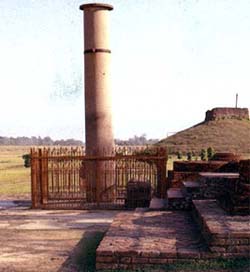
The second holy place: Bodh Gaya (Bodh-Gaya)
The second most famous holy place in the history of Buddhism is Bodh Gaya, where the Buddha attained enlightenment. Here the Buddha meditated for 49 days and nights under the pipala tree, next to the Ni Lien Thien river. Because of that eternal phenomenon, this place became Bodh Gaya, and the ancient pipala tree was named Bodhi tree (meaning “enlightenment, bodhi tree”).
It can be said that Bodh Gaya has become a cradle of Buddhist cultural history and Buddhist disciples all wish to visit this place at least once. The grass court where the Buddha meditated and the Bodhi tree were all carefully taken care of. The stupas and large and small stone pillars around Bodh Gaya were built by traveling monks from India, China and other countries as offerings when they came to worship this holy place, and documents recorded by Mr. Tam Tang Xuanzang, has allowed us to imagine the vibrant and bustling scene of this place in the past more than 2,500 years ago. The Bodhi tree is now the grandchild of thousands of original Bodhi trees, but the branches and leaves are still luxuriant and the trunk is large and strong.
It was Alexander Cunningham and a number of other scientists who were the first to excavate the inscriptions and pillars at Bodh Gaya. The Great Bodhi Tower has been restored many times at a huge cost. King Ashoka also built a temple at this holy place. The temple built by King Ashoka has been depicted extensively in Indian art; However, no trace of this temple’s remains can be found anymore.
The great Bodhi tower we see today is a new tower that was later restored. According to the description of Tripitaka Xuanzang, the great Bodhi stupa was built in the 7th century AD following the model of a great stupa in Burma (Burma).
Currently, the great stupa at Bodh Gaya is nearly 160 feet high and built in a quadrilateral shape. At the top is a pointed tower. In the tower, people carved the image of the Buddha who attained enlightenment. The north side of the tower is a narrow path 4 feet above the ground. People describe it as a small path that Buddha, after attaining enlightenment, meditated walking back and forth on this path. In addition, there are many lotus images carved on that road because people believe that with every step the Buddha took, lotus flowers bloomed there. People also see a patch of red sand stone next to the Bodhi tree, symbolizing the grass cushion on which more than 2,540 years ago, Buddha sat and attained enlightenment. There are many other carved structures engraved with images of Buddha and his great disciples, Brahmas. Those aesthetic architectures have attracted millions of people to visit Bodh Gaya more and more each year, creating a huge wave of tourism to the Buddha’s hometown, helping to increase India’s defense finances. significant profits.
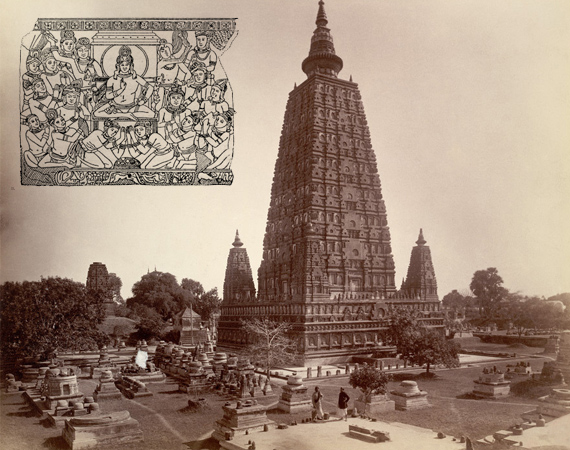
Third Sanctuary: Sarnath
Another memorable holy place in the history of Buddhism is the holy land of Isipitana or Sarnath. Here, in the silence of the Deer Park, Buddha preached his first sermon to the five brothers of Mr. Kieu Tran Nhu who had previously practiced asceticism with him. The content of the sermon is about the sufferings of human life and the ways to relieve those sufferings. This event has been dubbed “Zhuan Falun,” meaning Buddha turned the wheel of Dharma for the first time, marking a glorious era of a religion that has lasted for over 2,500 years to the present. .
Sarnath is the birthplace of the religion founded by Buddha Shakyamuni. Therefore, Sarnath became the largest Buddhist center that existed for over 1500 years. During the first centuries of the flourishing period of Buddhism, during the reign of King Ashoka, Sarnath became a famous place of debate between sects and religions. Two monks, Phap Hien and Tran Huyen Trang, came to worship this relic in the 5th and 7th centuries AD. The two of them left us many valuable documents about the history of this holy place. Here, King Ashoka also ordered people to build a pillar to mark the hermitage area in many different large and small buildings of more than 1,500 Buddhist monks coming to Sarnath. Among the remaining relics, one must mention a beautiful temple with a bronze Buddha statue in the form of turning the Dharma wheel, an ancient stupa and a stone pillar. All were built by King Ashoka. This holy land has flourished during many dynasties and has also been restored many times. According to inscriptions and archaeological evidence, it is known that the temple containing the statue of Buddha Zhuan Falun was restored by order of Queen Kumaradevi in the first half of the 12th century BC. Soon, this place was completely destroyed by the army of Muhammad Ghori, the army of the Huns and Mahmud Ghazni, but Sarnath was restored thanks to the efforts of Buddhist monks and nuns everywhere. However, later, because Buddhism declined in India, Sarnath, a once famous and glorious historical site, was lost in the ruins of the sands of time.
Today, the Indian Archaeological Institute has spent a lot of energy and finances in the excavation and restoration of the Sarnath holy site. When we come to Sarnath from Varanasi direction, we will see an octagonal plane of adobe rising from the ground. This flat surface is the remaining relic of a stupa that formerly marked the place where Buddha came to meet the five brothers of Mr. Kieu Tran Nhu. This octagonal tower was last restored by emir Akbar in 1588, of the Gupta dynasty.
Among the remaining ruins that were not destroyed by the armies is the Dhamekh stupa 150 feet above the ground. This tower was built with durable materials, giant stone blocks made of bricks and shaped like pillars. The images carved on the face of the tower tell us that the Dhamekh tower was built during the Gupta dynasty in the 6th century BC. The noun “Dhamekh” comes from the Sanskrit word “Dharmekh – dharma”. Not far from this tower to the west is a small tower built by King Ashoka. The tower built by King Ashoka, according to the description of Mr. Tran Huyen Trang, could be the place where Buddha meditated and preached to the 5 brothers Kieu Tran Nhu. A little further north, there is a very elaborately carved lion-head-shaped pillar. This lion pillar is now on display at the nearby archaeological museum. At this tower, we can still see large pieces of stone left from the main hall’s floor and large and small columns of a main gate leading to the main hall of the tower. In addition, we also see many fragments of Buddha and Bodhisattva statues bearing the sculptural marks of many different dynasties. The most beautiful Buddha statue carved from sand stone engraved with the image of Buddha Zhuan Falun is a beautiful statue bearing the mark of sculptural art of the Gupta dynasty.
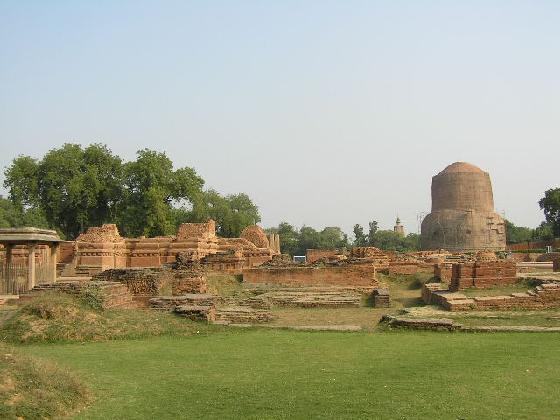
All sculptures of this era were engraved with eight historical events of the Buddha’s life such as the Buddha’s birth, enlightenment, turning the wheel of Dharma, entering Nirvana, performing miraculous powers, etc. More significantly is a stone parasol engraved with the complete sermon of the Four Noble Truths in the ancient Pali language.
Although much destroyed over time, Sarnath still attracts tourists to India to remember the image of the Buddha and his teachings that still echo eternally in the hearts of Buddhists.
Fourth holy place: Kusinagara
Kusinagara or Kusinara is the place where Buddha Shakyamuni passed away at the age of 80 under the canopy of a Sala tree. This place was later identified by archaeologists as Kasia in Deoria district of Uttar Pradesh.
Like other holy places related to historical events in the Buddha’s life, Kusinagara has become an important holy place for Buddhists to come and worship.
At that time, thousands of monasteries and stupas were built around this holy site. However, it is unclear for what reason, perhaps it was destroyed by the Muslim army or due to time fading and erasing the mark, this holy place was left in ruins. The two monks Phap Hien and Huyen Trang, when coming to worship this holy place, also had to utter words of sorrow when looking at the desolate and ruined landscape of Kusinagara.
Through excavations to find traces, people dug up some broken pieces of Buddha statues and patchy pillars. However, based on the signs of the remaining relics and inscriptions, this place is definitely the holy place of Buddha’s Nirvana. The Mahaparinirvana stupa that King Ashoka built can no longer be found and it is possible that this stupa was buried under the foundation of the Nirvana monastery built during the Gupta dynasty.
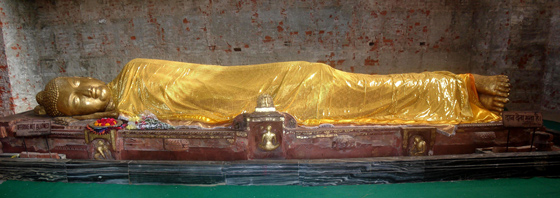
Buddha statue entering Nirvana
Among those relics, people found a statue of Buddha in the Nirvana posture. This statue was also broken and was skillfully repaired by sculptor Carlleyle. The great Ramabhar stupa was built right at the site of the Buddha’s body tea ceremony and his relics were divided into eight equal parts for the eight largest and most powerful kingdoms of that time.
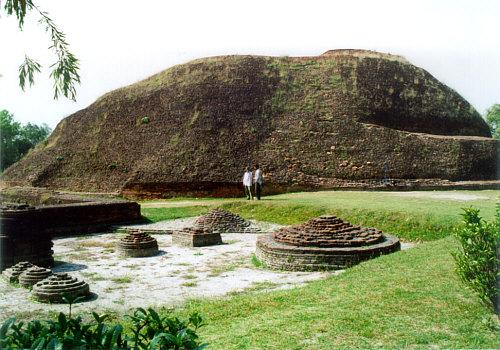
The place where Buddha’s golden body rests
Currently, archaeologists are still continuing the excavation of the Kusinagara holy site, hoping to find more evidence to shed more light on a sacred place that received the reincarnation of the Buddha Shakyamuni. Buddhist nuns
Fifth holy place: Sravasti
Sravasti, the capital of the ancient kingdom of Kosala, is revered by Buddhists because here more than 2,540 years ago, Buddha performed miraculous teachings to masters who worshiped the fire god.
According to historical records, Buddha performed miracles such as water appearing on his body, fire on his body, fire on his body, water on his body, or the sun and moon shining at the same time in the sky. , and many incarnations of Buddha. Those miracles have been the subject of many works of Indian art from ancient times to the present.
Even during the Buddha’s time, Sravasti was a bustling and prosperous Buddhist center. It was here that the wealthy Anathapindika spent gold to buy all the land for Prince Ky Da’s flower garden to build a monastery to make offerings to the Buddha and the monks. The story of Mr. Anathapindika’s lavish gold purchase of land greatly stimulated the aristocratic classes of kings, princes, and wealthy people, and it was also the subject of the absolute devotion of Mr. Anathapindika as well as his followers. later works of Indian art. Later, many monasteries and stupas were built scattered around this place, making Sravasti more famous and prosperous.
Archaeologists believe that Sravasti belongs to the Saheth – Maheth locality, located close to the border of Gonda and Bahraich districts of Utta – Pradesh. Here they found several inscriptions related to Ky Vien monastery in Sravasti.
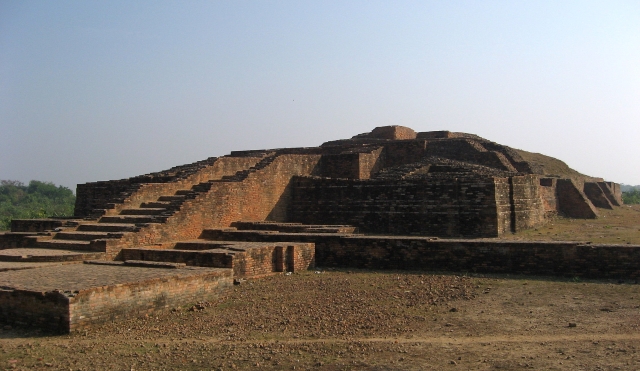
Saheth – Maheth includes two separate regions. The largest area, Maheth, covers 400 acres, and was once a prosperous provincial capital. Saheth is only 32 acres in size, located about 0.25 miles southwest of Ky Vien monastery. Excavations in the Maheth area have told us that Maheth was once a very wealthy and crowded city. Saheth, although smaller, is more famous because this is where the Buddha stopped to teach and many remaining foundations of monasteries, monasteries, and stupas remain; Therefore, most monks and tourists visit Saheth to worship and visit.
The relics on display bear signs of the Mauryan era until the years when Buddhism began to decline in India in the 12th century AD. Here, people see the oldest stupa built in the 3rd century BC, containing Buddha relics and a statue of Buddha’s head carved in the 1st century AD during the Bala dynasty. This statue of Buddha’s head is now displayed at the Indian Museum in Calcutta. Queen Kumaradevi, wife of King Govinda-Chandra, was the last person to financially sponsor the construction and restoration of the Ky Vien monastery in 1128-29.
Buddhism has now declined greatly in India and the site of Sravasti, once famous and glorious in the history of Indian Buddhism, was destroyed by the heels of the Muslim army and burned to the ground.
Sixth holy place: Sankasya
Another sacred place related to the life of the Buddha is Sankasya, where the Buddha performed miracles to the 33rd Dao Loi heaven to preach the Dharma to transform his mother, Queen Ma Gia, and the gods. The Buddha preached the Abhidharma Abhidharma in the Brahma heaven. This event happened after Buddha performed a miracle in Sravasti.
Sankasya, also known as Sankisa or Sanisa Basantapur, belongs to Farrukhabad district of Uttar Pradesh. This locality is known for its authenticity thanks to King Ashoka’s inscription engraved on an elephant statue marking this holy place.
Not only did Phap Hien and Huyen Tsang come to worship the holy place of Sankasya, but many other Chinese monks also visited this holy place – but the documents they left behind do not have enough evidence. to verify more clearly about this place. The current village in this holy place is located on a hill, 41 feet high and about 1,500 square meters wide. About 0.25 miles south is a stupa ordered by Queen Devi to be built. Scattered around this hill are piles of broken bricks and stones and the remains of city gates, beams, beams, etc. These ruins are not enough data for us to determine the history of the Sankasya sanctuary. .
The elephant statue cast by King Ashoka is the most important relic marking the site of Sankasya and future excavations hope to bring us more interesting things about Sankasya.
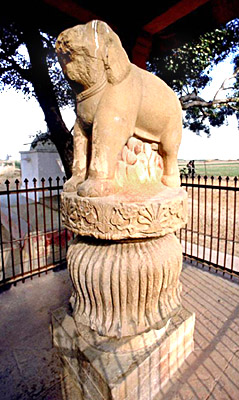
The image of an elephant statue at Sankasya cast by King Ashoka marks this place
Seventh holy place: Rajagriha
Rajagriha, the capital of the powerful Magadha kingdom, can be said to be very famous in the history of Buddhism for many reasons. Not only is Rajagriha where the Buddha stopped many times during his spiritual life, but it is also where Devadatta, the Buddha’s cousin, plotted many times to kill him. . Furthermore, in this capital, at Sattapanni cave on Vaibhara hill, the First Council was held here under the chairmanship of Upali and Ananda. The main points of Buddhist teachings and precepts are raised in this Council. Therefore, Rajagriha has become a famous and important place in the establishment and development of the Buddhist Sangha.
A famous city in the past, Rajagriha is now a town in Patna district of Bihar, surrounded by rolling hills and mountains. Rajagriha is also known as Vaibhara, Vipula, Ratna, Chatha, Udayagiri and Sonagiri. At the foot of the hill to the north of Rajagriha town in the past was the kingdom of King Ajatasatru, son of King Binh Sa (Bimbisara). After the reign of King Ajatasatru, crown prince Udayin succeeded the throne and moved the capital Kusumapura to another place and the next king Kalasola moved the capital to Pataliputra, so Rajagriha gradually lost its important role. it’s in the kingdom. However, despite many ups and downs in politics and religion, Rajagriha is always mentioned in the history of Indian Buddhism and the history of other religions.
Very little remains of the ancient city of Rajagriha. Through relics and broken inscriptions, archaeologists believe that this holy land was once the living place of many different religions. Even Sattapanni Cave, where the First Buddhist Congress gathered, also has faint traces. According to classics and historical documents, Sattapanni cave is located to the north of Baibhara hillside and scientist Stein was right when he said that the location of this cave is located in the north on a very large piece of land with many small caves. A particularly remarkable structure, Jarasandha Ki Baithak, on the eastern Vaibhara hillside, has uneven large and small cellars, described as the hermitage of Mahakasyapa, the presiding judge. During the First Council of the Great Council. Later, these caves were the residence of Jain monks at one time.
Gridhrakutta mountain was once the Buddhist hermitage, located close to Rajagriha city and according to some historical data as well as local people living in this area, Sonbhandar cave east of Vaibhara hill has Unexplored gold mine here.
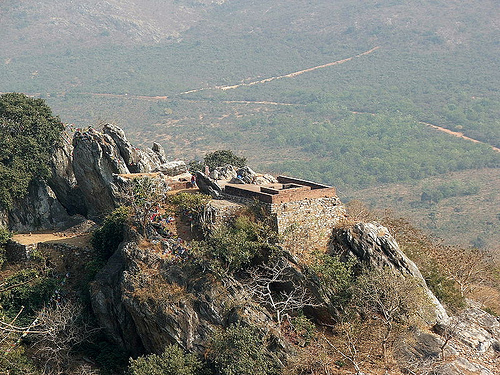
Rajagriha, now an attractive landscape for domestic and foreign tourists to visit, is not only a famous place in the history of Buddhism but also a place with many hot springs for healing and convalescence.
Eighth holy place: Vaisali (Visa Ly)
During the flourishing of Buddhism, Vaisali, the city of the mighty Lichchhavi kingdom, was the cradle of Buddhist philosophical culture.
Buddha stopped his preaching tour three times in this city. Here the Buddha received a bowl of honey offered by a group of monkeys and this is also the area where the Buddha announced that in 3 months he would enter Vo Du Nirvana. Furthermore, Vaisali is also the place where the Second Buddhist Congress gathered more than 100 years after the Buddha’s death. For Jains, Vaisali is also a holy place because Lord Mahavira, the 14th master of Jainism, was born.
Vaisali is a city in Muzaffarpur district of Bihar. During the Gupta dynasty, Vaisali was a bustling, prosperous capital. There are tourists, ships, and ports with bustling trade. Stores, banks, and offices are open day and night. The royal palace’s warehouses for rice, silk, etc. were full. Vaisali, at that time, helped the Gupta dynasty gain a strong foothold in the political arena until the Mauryan dynasty, Vaisali was still an important capital.
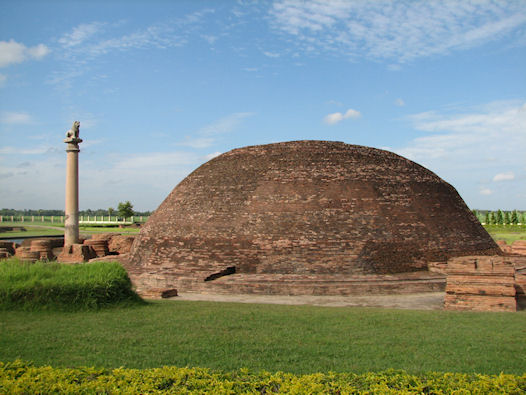
King Ashoka’s stupa and stone pillar
Two monks, Phap Hien and Huyen Trang, came to worship this holy place. According to Venerable Xuanzang, Vaisali is only about 10 or 12 square miles wide. Around Vaisali, there are countless stupas and stone steles that are countless. But time has cruelly erased those relics and only remains in the Kolhua area, 2 miles northwest of the city of Raja Bisal Ka Garh, a stone pillar carved with a lion statue 22 feet above the ground.
This lion stone pillar seems similar to the stone pillars that King Ashoka ordered to build, but there is no autograph or inscription that allows us to clearly identify this stone pillar as belonging to the reign of King Ashoka. Near this stone pillar, to the south, there is a small lake, which is said to be the puddle that 2,000 years ago, a group of monkeys dug to get water to offer to the Buddha to drink every day. Therefore, this lake is called Rama-Kund or Markata-Hraka, which means “lake of monkeys.” To the northwest, a ground of a temple remains. In the past, this temple was ordered by King Ashoka to be built with baked bricks and a tower with signs of King Ashoka’s construction remains on this once-rich and important piece of pristine land.
Time has faded and destroyed many temples and stupas, but Buddhist holy places are always the homeland of Buddhists.
Important Places
During the period of Buddhism’s development and prosperity, in addition to the sacred places related to the life of Buddha, important places in the history of Indian Buddhism such as Sanchi and Nalanda also contributed significantly to its splendor. of the Dharma.
The monasteries and monasteries in Gandhara, Taxila, Purushapura, West Pakistan, and East Pakistan are all Buddhist cultural centers. In addition to the unique aesthetic and architectural features, these Buddhist cultural centers are also the place where Buddhist heroes came from, creating very exciting and heroic philosophical and literary debates; Typical examples are the Buddhist centers of Sanchi, Nalanda, Ajanta and Ellora.
These places also change according to the law of impermanence of all things. Those remaining relics are not enough to bring light to the golden past of these places. However, even though they have faded from history, these important places are still attractive enough to attract scholars, monks, nuns, and Buddhists to explore remote areas to find them again. a little echo of the heyday of Indian Buddhism.
Sanchi
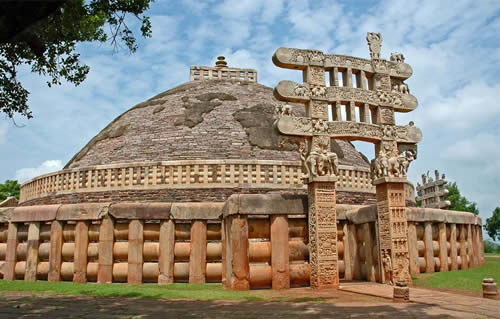
Sanchi is one of the important famous landmarks in the history of Indian Buddhism. This place has nothing to do with the life of Buddha, but Sanchi was a very famous and prosperous Buddhist cultural center during the peak of Buddhism. According to historical documents and Buddhist literature, Sanchi is the convergence of India’s artistic quintessence, and it can be said that Sanchi is India’s most beautiful architectural and sculptural work.
According to Sri Lankan historical records, King Ashoka married the daughter of a wealthy merchant and gave birth to a crown prince named Mahinda. Crown Prince Mahinda is a devout Buddhist and is very loved by his Father and Queen Mother. When King Ashoka was old and weak, he wanted to take his two sons and daughter to Sri Lanka to preach, and the Sanchi stupa was built on a hill in the vicinity of Vidisa, when Prince Mahinda stopped to rest on the hill. on the way to Ceylon to propagate Buddhism.
Whether the documents are correct or not, the inscriptions and stupas at Sanchi all bear the mark of King Ashoka’s time and people also believe that only King Ashoka, the great royal benefactor, had enough talent to develop. Sanchi became a prosperous and famous Buddhist cultural center.
Most of the stupas in Sanchi are located on a high hill surrounded by a solid stone wall in the 10th century AD. These stupas and inscriptions all have traces from the 3rd century BC to the 12th century AD, from the great Sanchi tower, which is 50 feet high and the diameter of the dome of the Sanchi tower is 100 feet, the largest tower. Up to the smallest tower, no more than 1 foot high, these large and small towers give the hill a majestic and majestic stance.
The great stupa at Sanchi was built with bricks and stones during the reign of King Ashoka, including tall solid stone pillars that stretch around the stupa, and the main gate of the stupa was built and carved with profound skill. Unique beauty as shown in the picture next. Two standing pillars carved with original ancient Sanskrit scriptures. The top of the column is carved with 2 elephants supporting 3 horizontal beams, with some places depicting elephants, lions, scriptures, etc. symbolizing the literary and philosophical activities of the Dharma periods, and Indian Buddhist Dharma statues. The four sides of the great tower have 4 gates including 1 large gate and 3 small gates. The other three small gates were also built and carved like the big gate with images of elephants, lions, men and women, horses, etc. depicting myths about the life and teachings of the World-Honored One. The mythological theories of the Buddha’s life described in the Sutra of the Buddha’s Life were carved and sculpted by Indian artists on the city gates and tower walls. Also noteworthy is the image of King Ashoka carved on a city gate, depicting the scene of King Ashoka’s visit to worship the Bodhi tree in Bodh Gaya. The image of King Ashoka in Sanchi is the only image carved by the King’s artisans and subjects to commemorate the gratitude of a great benefactor of Buddhism who wholeheartedly supported the cause of propagation. Dharma.
These works of art all reflect the religious fervor of the local people of the Sanchi region. They spent a lot of money and it took many years to complete these beautiful architectural works. Every engraved line, every carving, every drawing carries within it the soul of the artist’s love of art, devotion, dedication and gratitude. These artisans do their work not for fame or position, so their minds are comfortable and peaceful, focusing their whole soul on art. Therefore, the works exude a strong vitality that makes viewers feel deeply moved as if they were living in the light of the Golden Path of Liberation.
Among these towers, there are three that receive the most attention.
The first tower is the third tower, located northeast of the Great Tower. Although it is the smallest tower, it is a model tower. In the relic worship room, General Cunningham discovered the relics of Sariputta and Maha Maudgalyayana, two great disciples of the Buddha. These two are very famous. Sariputta is the “First Wisdom.” Maudgalyayana is the “First Divine Power.” The relics of two great disciples of the Buddha were brought back to England by archaeological groups and displayed. at the London City Museum, and then brought it back to worship at Sanchi in this tower number 3. In the past, this tower number 3 was often excavated.
The second tower is located on the western hillside. This tower has no relics, no main gate, but still retains a number of tools left behind by ancient artisans, and these materials help people know that it was more than 2,500 years ago. years, how did the artisans cast and paint the statues? The sculptures in this tower seem more modern than the architecture of the Great Tower.
The last small tower near the foot of the western hill is the place to worship the relics of Mr. Ca Diep. In addition to this special feature, the tower is also special with its pillars, column heads, and walls carved with extremely unique and exquisite images.
Many small towers scattered around the Great Tower were found. In it, people dug up many broken pieces of statues, inscriptions, etc. In Sonari, a few miles from Sanchi, many relics were found. In Satdhara, three miles away, people found relics of Sariputta in two small stupas, similar to the relics found in the stupa of Sanchi. There are many towers in the Bhojpur and Andher regions whose markings are faint and cannot help us determine whether the towers were built during the Asoka dynasty or after the first century AD.
Among those stupas, the most notable is King Ashoka’s stone pillar with statues of four lions back to back, near the main gate of the Southern Great Tower of Sanchi. On the top of the pillar, there are engraved words declaring the order “Segregation and destruction of the Sangha will be prohibited, you will be severely punished” by King Ashoka. In addition, temples No. 17 and 18 were built between the 7th and 12th centuries AD, with Buddha statues, stone pillars, and carved walls also contributing to the beautiful construction. in Sanchi.
The stupas at Sanchi have been preserved and restored very carefully and skillfully by sculptors and scholarly archaeologists. The most instrumental person in this excavation restoration was Mr. John Marshall, the former general director of the National Archaeological Institute of India. He renovated, repaired, and restored the monuments and visitors to Sanchi can imagine that they are returning to the golden past of the Dharma with majestic towers towering in a corner of the sky.
Ajanta and Ellora
Two more notable famous places are Ajanta and Ellora located in the Maharashtra region. In a small narrow valley is the stunningly beautiful Ajanta cave with ruins of temples and monasteries.
From natural rocks, artisans have carved and carved statues of Buddha, Bodhisattva or extremely sophisticated works of art. The walls, stone pillars, and ceilings of the cave are all exquisitely carved, bearing the mark of Buddhist art that spans 800 years, and there is no monument in India that can compare with these masterpieces. This.
The caves at Ellora were excavated and found on a very large rocky plateau. Unlike Ajanta, Ellora symbolizes the artistic synthesis of three major religions in India. They are: Buddhism, Brahmanism, and Jainism. The famous Kailasa temple of Brahmanism is the best representative of world art with artistically designed ceilings, corridors, lively spirit walls through carved sculptures, and paintings. According to legends, all of these relics were carved from rock beds, making the temple in Ellora cave even more famous.
The caves at Ajanta bear the mark of the last centuries of the era before God, and in chronological order, Ajanta has contributed to the development of art, fine arts, sculpture, and construction miracles. Caves No. 9 and No. 10 are the oldest caves located deep in the heart of the rock caves in Ajanta. From these rows of stone caves all the way to the 19th and 26th caves, people see countless images and statues of Buddha in many different designs. Statues and paintings depict the Buddha in a meditative sitting position, cross-legged, or in the standing position of Zhuan Falun. Ancient artists offered their artistic heart and devotion to the Buddha through their drawings and carvings.

Caves 16, 17, and 02 are the most important caves. The 16th and 17th caves were built in 500 AD and the 1st and 2nd caves were built a century later. These caves are very beautiful thanks to the carved stone pillars and the airiness of the large corridors. But the splendor of Ajanta is due more properly to the enormous quantity of paintings. Famous artists painted the stories of the Buddha’s life according to the Buddha’s Life Sutra and added portraits of the Buddha, Bodhisattvas and Brahmas.
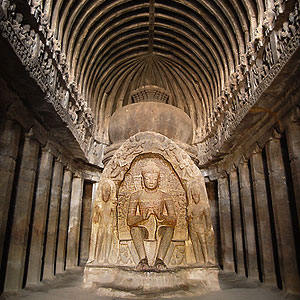
Among the carved caves in Ellora, 12 caves along the south direction are decorated according to Buddhist legends, in addition to the Brahmanical and Jain style caves. The ruins at Ajanta and Ellora often have the footprints of scientists, archaeologists and artisans coming to admire and learn rather than tourists, because this cave is located deeper and higher in the mountains and forests. However, Ajanta and Ellora are still listed as famous scenic spots in India.
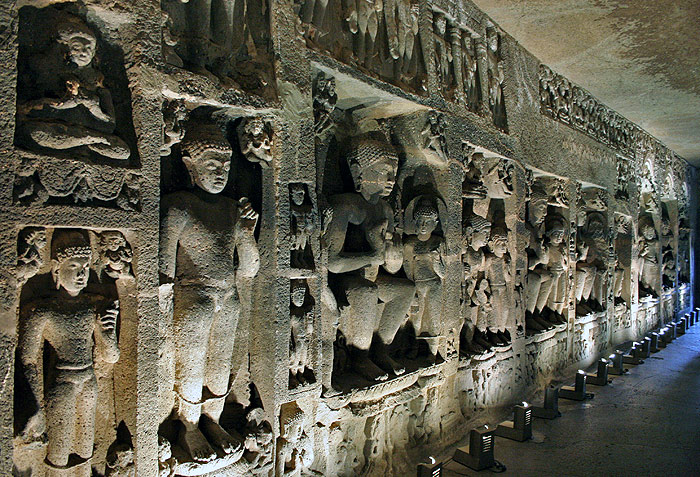
Nalanda
Nalanda Monastery occupies an extremely important position in the history of modern Buddhism. According to tradition, Buddha visited Nalanda monastery several times and the history of this monastery may bear the mark of King Ashoka’s reign. However, the excavations are not enough to prove the time when this monastery was built and evidence such as inscriptions, seals, and a few remaining relics coincide with some historical sites. Nalanda monastery was prosperous. and was famous from the 5th century until the late 12th century AD. It was also here that the famous Chinese traveling monk, Tran Huyen Trang, came to stay several times. He recorded many data and diagrams of many different structures of Nalanda monastery, a monastery that is also an academy that can accommodate more than 10,000 monks who practice here every year to practice and study the scriptures. and debate. Venerable Tripitaka Xuanzang also acknowledged the offerings and support of King Harsha and many kings of subsequent dynasties. I Tsing, a Chinese monk, also visited Nalanda monastery and noted that the monks residing in Nalanda were supported by more than 200 surrounding villages and under the support of more than 200 surrounding villages. support of many kings.
Nalanda entered the history of world Buddhism because here masters Silabhadra, Santarakshita and Atisa Dipankara once studied and contributed to the fame of Nalanda monastery.
The devastation of Nalanda has made visitors shocked and saddened by the once-famous Buddhist monastery, now only a few relics of temples, towers and monk rooms remain. The view of the remaining relics also tells us that in the past, the towers and shrines occupied the length from North to South, and the monasteries for monks to reside in stretched from the East to the West hillside. of several huge hill ranges. Although Nalanda is now in ruins, it still allows us to imagine the bustling, prosperous scene of the activities of tens of thousands of monks several centuries ago.
Tower number 3 is a massive structure located in the middle of the southwest hillside and surrounded by countless small towers. The first tower was just a small tower, but gradually it was built larger and larger. The tower has now been expanded up to 7 times, each time it is larger and the sculptures are more aesthetic and unique. The base of the tower is still square according to the architecture of the first tower, but when it was rebuilt for the 5th time, the artisans carved and painted four more sides of the tower with large bricks engraved with Buddhist scriptures on top. inscription in the 6th century AD.
To the north of this great tower are rows of monasteries that have been restored and rebuilt many times. Here, visitors can still see traces of many shrines, small towers, etc. At a nearby museum, many relics and broken statues of Buddha and Bodhisattva are displayed. These relics were found during excavations of Nalanda monastery.
The documents on inscriptions found in Nalanda are not few. People found bronze, stone, brick inscriptions, seals, and terracotta pens. Brick inscriptions engraved with sutras or teachings on the Twelve Causes of Dependent Origination and Dharani mantras, these inscriptions are carefully preserved and displayed at the Indian Archaeological Museum.
Nalanda is still famous thanks to the support of many kings and royal families such as kings Narasimhagupta, Kumaragupta II, Vainyagupta and Vishnugupta of the Gupta royal dynasty, Sarvavarman and Avantivarman of the Maukhari dynasty, Bhaskaravarman of Kamarupa, Harshvardhana of Kanauj and many generations of other kings have continuously donated to Nalanda monastery for several centuries. People also found a stone inscription engraved with the royal family name of King Yasovarman of Kanauj, and a bronze inscription with the names of Pala kings such as King Dharmapala, King Devapala, King Balaputradeva of the Sailendra dynasty. During the life of the Pala kings, King Mahipala the First was the last person to sponsor the renovation of Nalanda monastery with the contribution of monk Vipulasrimitra.
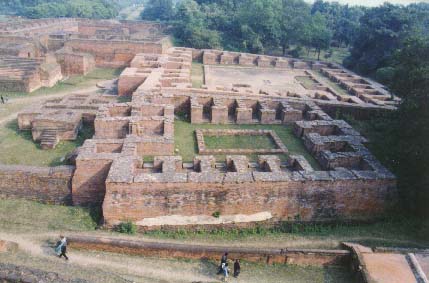
Theravada and Mahayana Buddhist teachings were taught by monks at Nalanda, but later the influence of Esoteric Buddhism spread among the monks, and mixed with the mysteries of Brahmanical Esotericism. Buddhism causes the Buddhist academic teachings to change unfavorably and incorrectly. Later, because of conflicting divisions within the Sangha, Islam took the opportunity to invade and destroy famous Buddhist sites, and a true religion, famous for the philosophy of Buddha Shakyamuni. Mau Ni has faded over time, leaving little trace in the Buddha’s homeland.
Epilogue:
Buddhism is a major religion in Asia. Through many ups and downs in history, Buddhism has also been used by many other religions to mix false doctrines with the true path.
However, the philosophies of the Four Noble Truths, the Twelve Causes of Dependent Origination, Prajna, and Nirvana of tranquility still stand firm and shine brightly in the sky of religious scholarship, and the holy places are forever the place to find the source. Liberation of Buddhists around the world.





